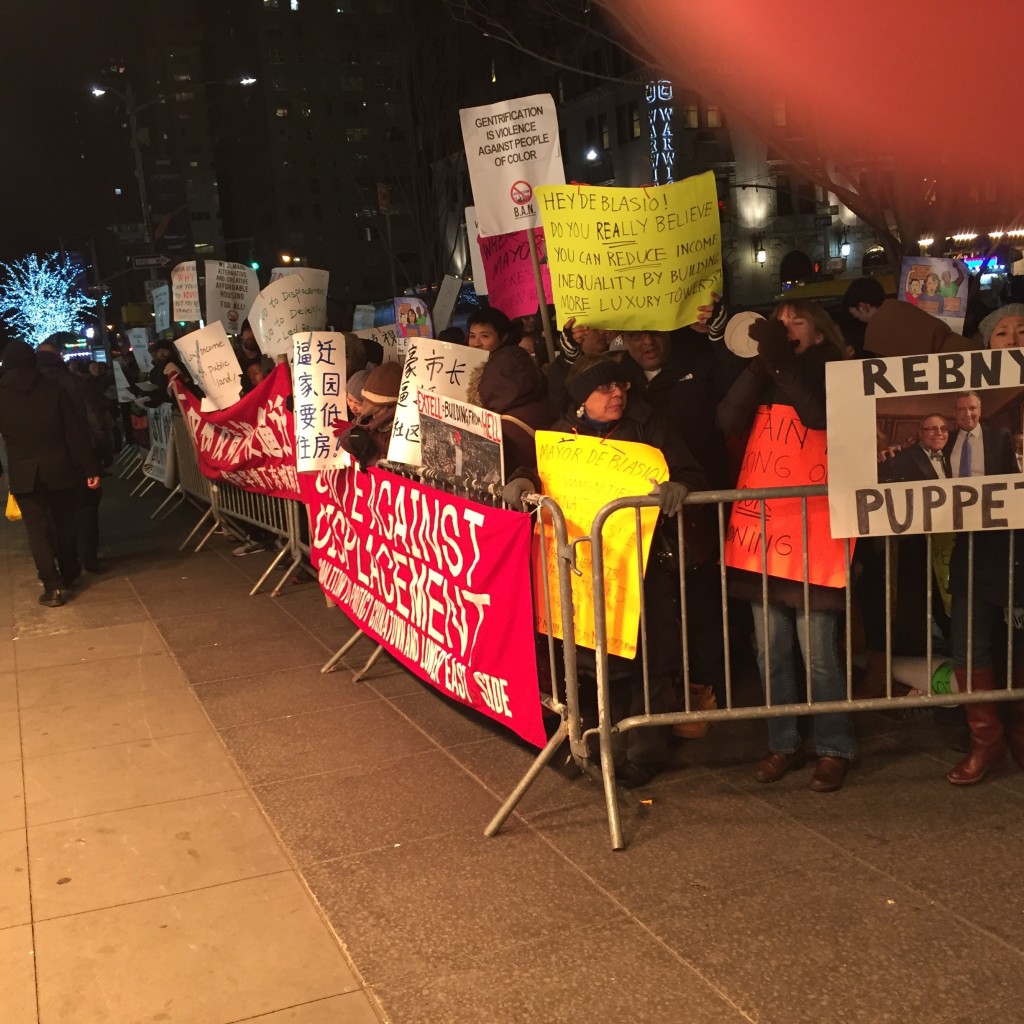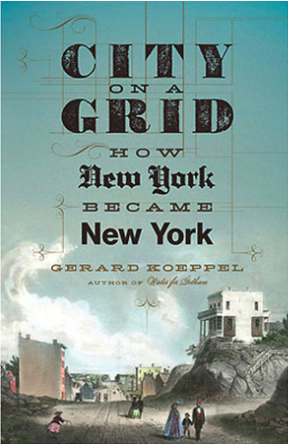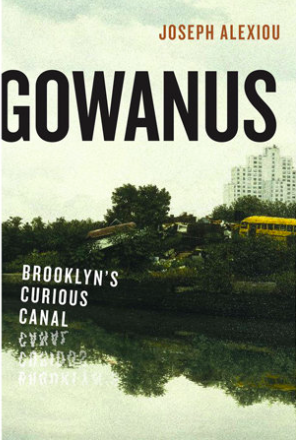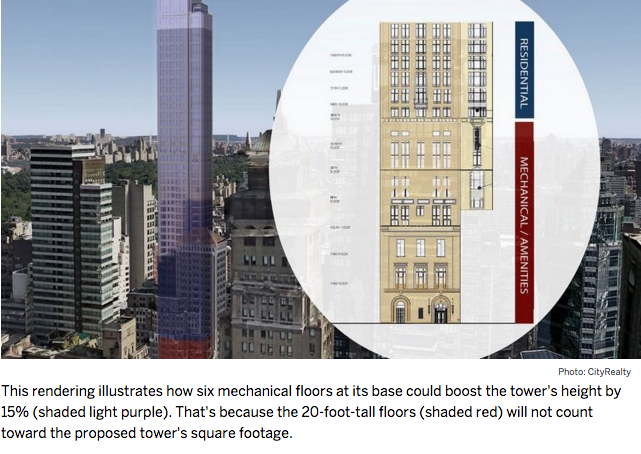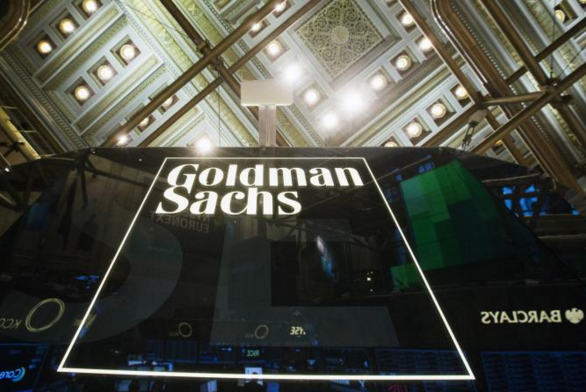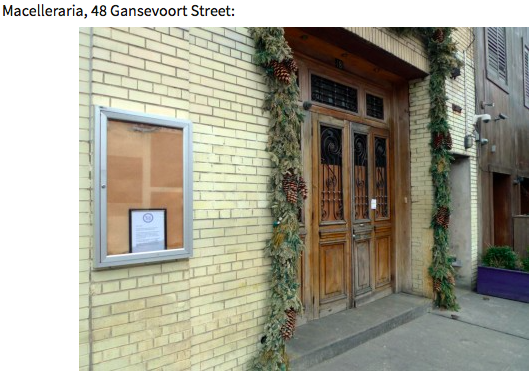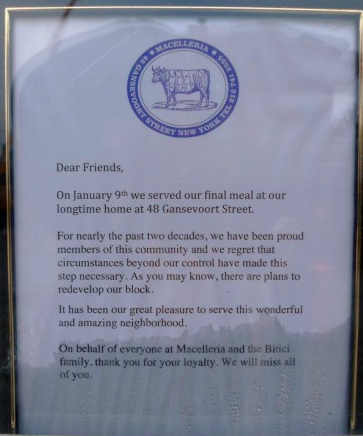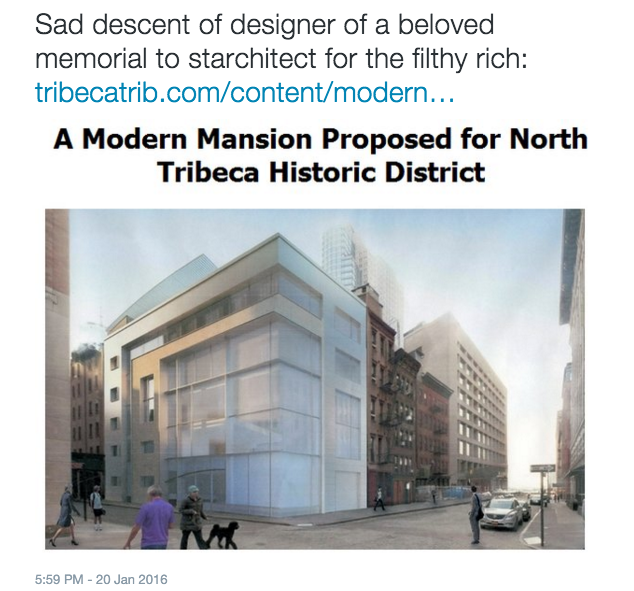Wow! Councilmember Ben Kallos goes to bat for the East Fifties!
Would that every councilmember would fight for their neighborhood like Kallos fights for the East Fifties. He has worked with one of our coalition members and petition co-sponsors, the East Fifties Alliance, to develop a height restriction for the Sutton Place Area. About time! And this kind of contextual height restriction needs to be all over the city, and married to restrictions on zoning lot mergers, air rights transfers, and elimination of the “mechanical” loophole described below.
Read all about this amazing news here at the East River Fifties alliance website:
Demonstration Against REBNY’s ties to Politicians a success
On a freezing bone-chilling night of Jan. 21st, about 150 people turned out to picket the annual gala of the Real Estate Board of New York. The police kept them tightly squeezed in one corner of the street. But one of the doorman of the Hilton came over to join in the picket and the police seemed to be enjoying the show.
Democracy in Battery Park City?
Governor Cuomo is facing pressure to allow residents on the Battery Park City Authority’s board. As the current governing body of the neighborhood, the Authority has not necessarily followed the interests of residents, beyond lavish funding of the gorgeous promenade. The Battery Park City Committee of the Community Board is now seeking to have Governor Cuomo appoint residents to a majority of the seats on the board. Currently, Cuomo appoints all members of the board and, to date, only one resident has ever served on it. The current board members are, coincidently, large donors to Cuomo’s campaign finances.
Battery Park City in landfill and development upon it was supposed to create a revenue stream to develop affordable housing in other areas of the city. Over the years, it seems that only a portion of its revenue gets used for that original purpose and lot of it is used to plug other budget holes for the city and state. The Daily News featured an op-ed recently that proposed leveraging the BPCA’s money to provide a revenue stream to finance a bond issue that could pay for 100% affordable housing elsewhere in the city. Would that be possible if residents of BPC controlled the budget?
To read more about the civic unrest in Battery Park City, click here.
Image courtesy of Batter Park City Authority. Makes you wonder…opportunity for whom?
Heads-up: Two New Books on New York City Planning and Development
The New York Times Book Review this past week mentioned two new titles this week worth seeking out. They deal with the historical development and construction of our city.
City on a Grid, by Gerard Koeppel, takes a look at the 1811 announcement of the grid system as a pivotal change that would shape the future of New York City. Koeppel focuses on the intentions and meaning behind the grid and looks to explain how the system became such a large part of the City’s identity.
Gowanus, by Joseph Alexiou, highlights the transition of this area from an estuary to a shipping canal and how this has affected the current condition of the waterfront.
To read the reviews in the Times, click here.
An Aside: Must we blame ourselves for traffic congestion, not the Department of Transportation?
As the city is more and more clogged by street traffic, we New Yorkers have at times blamed Uber or tourists or commuters for the slow-torture involved in moving across the city in a cab at so many times of the day. A new report, however, raises a new issue. In last weekend’s New York Times there was a discussed a recent traffic study released conducted during the Uber debate.
The study places the blame of exorbitant congestion on “population growth, more tourists, an increase in deliveries, and street construction.” The deliveries point got me wondering about that “increase in deliveries”. Am I, as an Amazon Prime subscriber, part of the problem even though I don’t even have a car? Or is the increase in deliveries due to over-development?
Should I wish to be part of the solution, should I dump by prime account and do more shopping in stores that I can walk to or take the subway to? Hmm, but then I would have to get off my computer….
To read the full article, click here.
Image courtesy of Inside Rensselaer.
How to build a super tower: Put it on stilts and get a Loophole from City Planning
It turns out that when the city assigns developers the total number of square feet they can use to build a new tower, the area assigned to “mechanical space” (meaning space devoted to elevator, heating, and air conditioning equipment) does not count in their allowance. Does that sound like a loophole to get around height restrictions?
In a wonderfully terrifying article posted in Crain’s New York Business, Daniel Geiger discusses the impact this loophole for developers is having in the making of super-tall skyscrapers. “Because the mechanical space acts as a platform that elevates the building, most of the [new developments] will start on the 21st floor,” according to a spokeswoman. “That’s 190 feet above street level. At that height, the views are sweeping enough to command many millions of dollars—much more than they would be worth nearer to the ground.”
Contrary to the excitement real estate developers have for this loophole, others are not as thrilled. “It’s like a booster chair,” said Mary Rowe, an executive vice president at the Municipal Art Society. “You want to have a city that happens on purpose, not an accidental skyline. This is not living up to the intention of the zoning.”To read the full article, click here.
Can We Put Money Won From the Banks Back Into 100% Affordable Housing?
Affordable housing can be thought of as a public good. Yet the city says it cannot build any affordable housing because it broke, that the federal government will not help, and so the city must make deals with developers. Those deals usually mean that the city allows developers to build taller than current zoning allows in exchange for a modest bit of affordable housing, housing which is only temporarily affordable and which housing activists are saying is not truly affordable. That sounds like a bad deal.
But, the other question is this: is it true that no money can be found? Well….it turns out there are stashes of money all over the place. Here is one:
In the latest of the legal battles to force banks to compensate for damage done to the (world?) during the financial and housing crisis of 2008, Goldman Sachs is now paying a $5 billion fine. Goldman’s penalty was smaller than that of firms such as Bank of America and JPMorgan Chase. In the seven years since the financial crisis, the amount of fine money being piled up is substantial, into the many billions. I have heard it goes into a trust fund run by the Treasury, but someone who knows better should please corect me. But why can’t some of this pile be used for 100% affordable housing at a human-scale?
Both the Wall Street Journal and The New York Times have written good articles about this settlement. To read their full articles, click here and here.
Image courtesy of International Business Times.
Gansevoort Street Update: “Intentional Blight?”
The Save Gansevoort group is calling attention to what they see as “intentional blight” being inflicted on their neighborhood by the developers of the proposed massive Gansevoort project–Aurora Capital and Gottlieb Real Estate. Local businesses are being forced out months ahead of any actual construction in order to make the neighborhood look decrepit, uninhabited, and unworthy of preservation.
To read more about this situation, and to sign the petition to save Gansevoort Street, click here.
Images courtesy of SaveGansevoort.org
Quote of the Week & Eyesore of the Month!
Tribeca has been talking a lot about the building shown below. It would arise inside our historic district. Because it has Maya Lin’s name attached to it – like magic pixie dust – we are all supposed to like it. Well….. there is not agreement on this issue. On the bright side, it is not a tower. On the other hand, it does not fit with Tribeca’s historic district. It ignores the existing architectural language and tries to make a different statement, to stand out and say, “look at me” I’m different than everything around me!” In doing that, it draws our eyes and attention away from the historic district, which is a conceptual error. When you have a historic district, it is supposed to be the star of the show from the point of view of the pedestrian experience, not the new in-fill. Those interested in this issue should consult the best book ever written on the subject, “The Future of the Past” by Steven Semes.
The problem of how to build inside historic districts by being faithful to the surrounding architectural language is also a debate our city should be having about our historic districts.
Meanwhile, Tribecan and policy wonk Charles Komanoff gets the quote of the week prize for his take on the Maya Lin building, mentioned on his twitter feed, which read: “Sad descent of designer of a beloved memorial to starchitect for the filthy rich.” .
To read the full article about Maya Lin’s new project in the Tribeca Trib, click here.
That’s all for this week. Next week expect more on community planning.
Putting out these newsletters is a big job, so volunteer proofreaders, news summarizers, graphic designers, and wordpress specialists all welcome on Thursdays to help our intern Darcy Riley and East Fifties volunteer Louise Carhart put all this together.
Don’t forget to sign the petition here for a human-scale city, and send a”one-click” letter against ZQH and MIH to all the City Councilmembers here.

